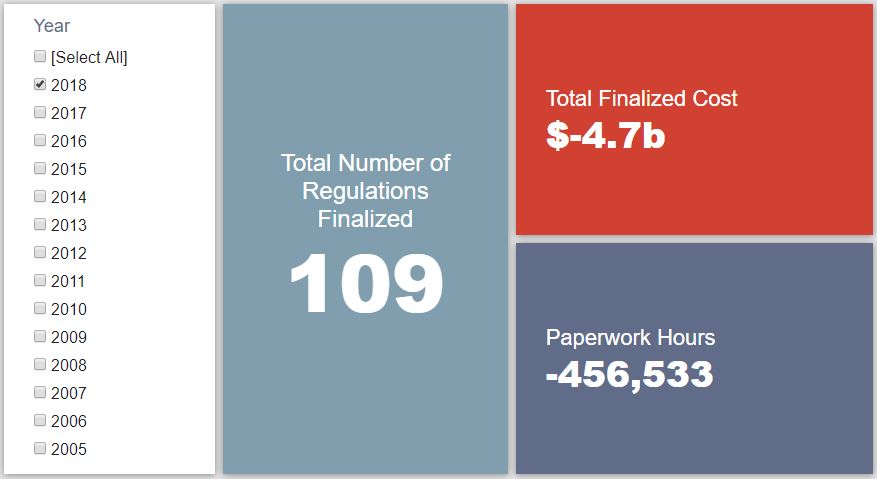Week in Regulation
June 4, 2018
A Short, But Generally Deregulatory Week
The four-day work week largely brought the same trends as its predecessor: a pronounced deregulatory tilt and a preponderance of proposed rules. The most notable proposal was an Environmental Protection Agency (EPA) rulemaking that could provide $875 million in overall savings. Between both proposed and final rules, agencies published roughly $795.6 million in net cost savings and 1,078,476 hours of paperwork cuts. The per capita regulatory burden for 2018 is negative $14.51.
Regulatory Toplines
- New Proposed Rules: 37
- New Final Rules: 58
- 2018 Total Pages of Regulation: 25,318
- 2018 Final Rules: -$4.7 Billion
- 2018 Proposed Rules: $8.3 Billion
Tracking Regulatory Modernization
An EPA measure regarding “Accidental Release Prevention Requirements” drove most of the potential cost savings this week. The proposed rule seeks to make significant changes to a January 2017 rule regarding such requirements. EPA estimates that these amendments will bring roughly $89 million in annual savings and reduce the paperwork burden by nearly 1.1 million hours (relative to the original rule). However, since it is still a proposed rule, these savings do not apply to the Fiscal Year 2018 regulatory budget under Executive Order (EO) 13,771.
There was one final rule related to EO 13,771 last week, and it carries a somewhat complicated status. The joint rule from the Departments of Homeland Security and Labor increases the cap on H-2B Temporary Nonagricultural Worker visas. According to the rule’s text: “OMB considers this final rule to be an Executive Order 13771 deregulatory action.” This is likely due to how it opens further visa slots. However, the only quantified economic estimates included are $10.3 million in costs. Thus, while it may have qualitatively deregulatory effects, in terms of EO 13,771 accounting it is a slight cost increase.
According to AAF analysis, since the start of FY 2018 (beginning Oct. 1, 2017), executive agencies have promulgated 38 deregulatory actions with quantified estimates against five regulatory measures that impose costs, under the rubric created by EO 13,771 and the administration’s subsequent guidance document on the matter. These rules combine for net annual savings of roughly $1.2 billion. This means that agencies have thus far surpassed the administration’s cumulative goal for FY 2018 of $687 million in net annual savings. In fact, according to the administration’s latest Unified Agenda, agencies are on track to roughly double that goal.
Click here to view AAF’s examination of the administration’s progress under the “one-in, two-out” executive order through the end of Fiscal Year 2017.
State of Major Obama-Era Initiatives
Based on total lifetime costs of the regulations, the Affordable Care Act has imposed costs of $52.9 billion in final state and private-sector burdens and 176.9 million annual paperwork hours.
Since passage, the Dodd-Frank financial reform legislation has produced more than 82.9 million final paperwork burden hours and imposed $38.9 billion in direct compliance costs.
Total Burdens
Since January 1, the federal government has published $3.5 billion in net costs (despite $4.7 billion in net savings from final rules) and new paperwork burdens amounting to 1.7 million hours (however, this includes 456,533 hours cut under final rules). Click here for the latest Reg Rodeo findings.











